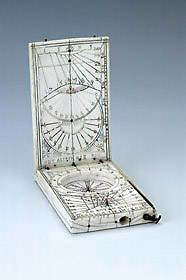
 |
| Catalogue |
 |
 Diptych Dial The inner side of the upper leaf has the date '15 43' on the top and a pin gnomon dial (pin missing) for Italian hours, numbered in green-blue from 14 to 24. Below is a vertical string gnomon dial (string missing) for common hours numbered from 7 to 12 to 5 and below, a pin gnomon dial (pin missing) for common hours numbered in red from 6 to 12 to 6. At the bottom of the leaf is the inscription 'GOT ALLEI[N] [D]IE ERR'. In the spandrel spaces is the same decoration as on the outer side and on the right is an unequal scale for adjusting the latitudes, marked in red from 30? to 80? by 2?, numbered by 10?. The inner side of the lower face has a compass vane (needle, ring and glass missing) with eight main winds named and a string gnomon dial for common hours numbered from 4 to 12 to 8 with dots for the half hours. Below, is a pin gnomon dial with Italian hours numbered in green from 10 to 23 and Babylonian hours numbered in red from 1 to 14. At the bottom is the inscription 'IS EX AD S{E}XTVM CLIMA HOROLOG I V I[N]TEGRV ('this is a dial precise to the 6th clima', probably referring to the climates as defined by Ptolemy). On the right-hand side is a brass arm for adjusting the latitude. The outer side of the lower leaf is blank except for the maker's mark in the form of a sheep. The bottom edge of the lower leaf has a compartment for stowing the pin. See P. Gouk, The Ivory Sundials of Nuremberg 1500-1700 (Cambridge, 1988). Ilaria Meliconi |



